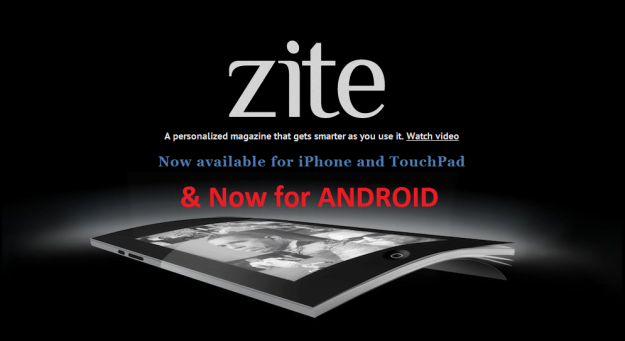
Long an iOS-only app, personal newsreader app Zite has finally, after two years in business, announced the release of its Android app.
Overall, Zite has been an effective personal curation companion. For voracious news readers, the application aggregates the latest need-to-read articles, while occasionally throwing in an outlier headline, a story outside of what a user may deem as their typical interest. In the world where blogs are viable competitors to traditional publications, most news will be old in a matter of minutes. Zite keeps the news fresh and to-the-minute.
So why has it taken nearly two years to step into the Android market? It’s the fault of the “wide variances of devices and OS versions in the Android ecosystem,” Zite writes on its blog.
It’s a common sentiment that Android developers share. The inconsistent screen ratios and the myriad of OS versions are a headache for developers, and a luxury that consumers take for granted. But Google says the whole thing is just one big misunderstanding.
“It’s a very common misconception that developers have to develop a different app for each of these screen sizes, but it’s actually not the way Android was developed. It was designed with the flexibility built in to build with multiple screen sizes,” a Google spokesperson told Digital Trends. “In practice, one application file can actually service a wide variety of screen sizes in the same way that you can develop a website for a range of different screen sizes.”
This is all true, at least partially. Google offers an API that allows the resizing of the user interface to fit a multitude of screens. But there’s a fine print in its developer’s guide that reveals far more than what Google had informed us. Google’s developer’s guide states: “You should make the effort to optimize your application for different screen sizes and densities. In doing so, you maximize the user experience for all devices and your users believe that your application was actually designed for their devices — rather than simply stretched to fit the screen on their devices.”
“Ice Cream Sandwich, or Android 4.0, only improves this even more by creating one platform,” the Google spokesperson added. “Essentially you can create one application that works on all devices.” Unfortunately, ICS is currently available on 1.6 percent of Android devices. Unless developers are considering developing for the 1 percent, the inconvenience of designing for multiple Android OS’s continue to exist.
The Android Zite app only exhibits a single minor change from its iPhone counterpart, and one that we actually prefer. To help gauge the users’ future interests, the Android version uses an improved up-voting and down-voting system. The thumbs up and thumbs down symbols, Android users will find, are conveniently situated in the top navigational bar. On the iPhone, the voting buttons are located at the bottom of the screen. It is of course possible that the changes will translate over to the iOS version of Zite.
Aside from this minor change, users of either app will find few differences. Zite is now available for free from Google Play.
You can find screenshots of the Android app in action below:



Editors' Recommendations
- An Apple insider just revealed how iOS 18’s AI features will work
- How to find your lost phone (tips for iPhone and Android)
- How to use iMessage on an Android phone or tablet
- Samsung’s newest Android tablet is a perfect iPad alternative
- Android phones finally have their own version of AirTags


